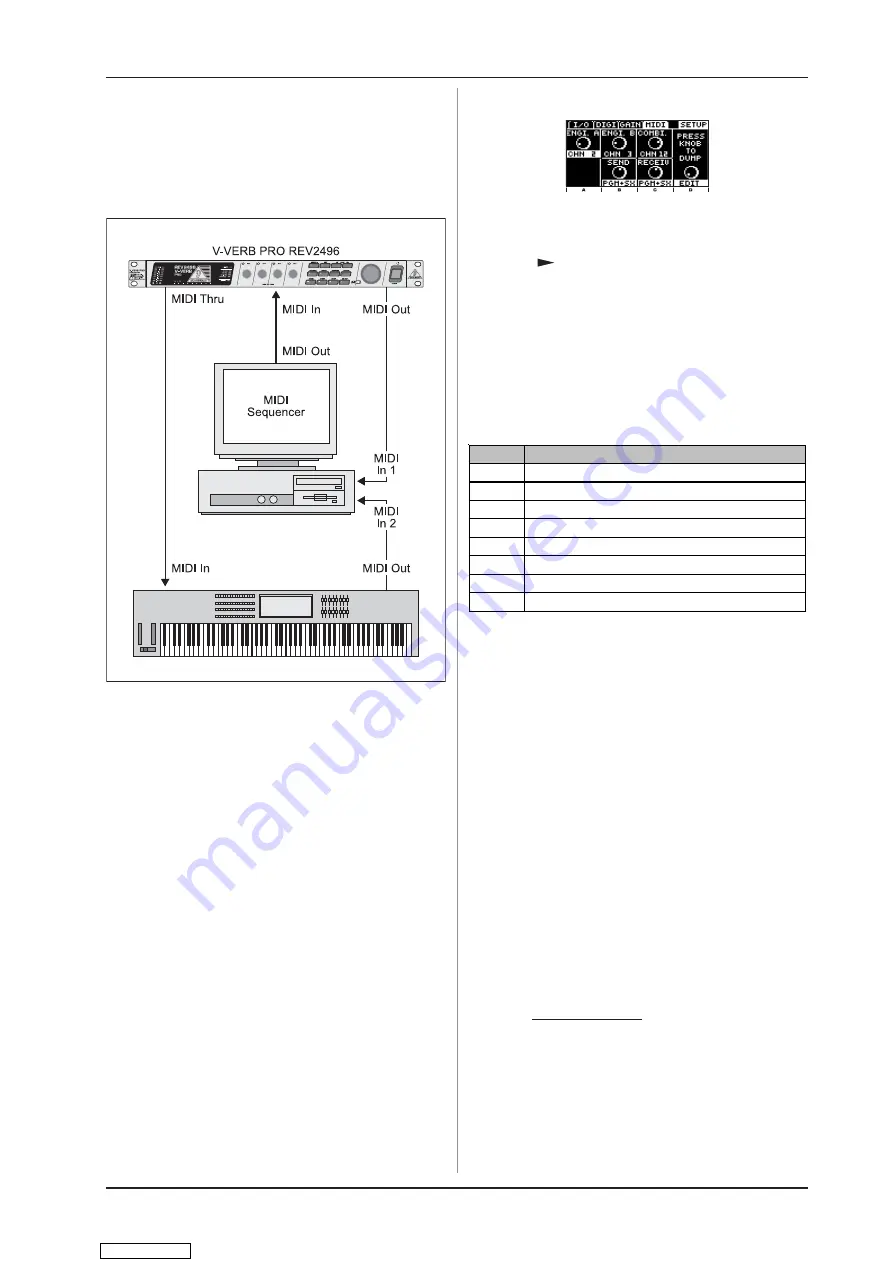
23
V-VERB PRO REV2496
6. MIDI FUNCTIONS
MIDI (Musical Instruments Digital Interface) lets several musical
instruments/devices communicate using a standardized
connector. Units with MIDI connectors speak the same language
so that an entire network of several MIDI units can be created.
For example, you can wire your V-VERB PRO like this:
Fig. 6.1: V-VERB PRO in a MIDI connection with a sequencer
(computer) and a keyboard
All MIDI commands that are sent to the REV2496 are received
through the
MIDI IN connector
. If for example you wish to
integrate the REV2496 in your studio, you can connect your
sequencer to the MIDI In connector, which will allow you to
control your REV2496.
The
MIDI THRU connector
is used for
forwarding incoming MIDI commands. This means that all control
commands that get into the V-VERB PRO through the MIDI IN
connector can be passed onto other MIDI-enabled equipment or
instruments using the MIDI THRU connector. With the
MIDI OUT
connector
, you can generally send MIDI data from the REV2496.
Different kinds of equipment functions can be controlled via
MIDI. MIDI messages are received on another MIDI-enabled device
(e.g. a MIDI sequencer or a MIDI foot controller). The MIDI
messages that need to be sent have to be set in the MIDI
sequencer. The MIDI functions contain program-change
commands (program changes), controller messages and an
abundant SysEx implementation (system-specific data). Using
program changes, you can switch presets. Controlling individual
effect parameters in real time is carried out by the controller.
Transmitting the entire memory contents for backup purposes is
done by performing a SysEx dump.
Separation into 16 MIDI channels lets you control up to 16
different pieces of equipment/instruments within a single MIDI
network. In the case of the REV2496, you can select different
MIDI channels for engine A, engine B and COMBI. This way, MIDI
data can be separately addressed for each engine. The
advantage of doing this is that incoming program changes wont
switch all programs but only those in the respective engine.
6. MIDI FUNCTIONS
6.1 MIDI settings
Fig. 6.2: MIDI SETUP page
All MIDI settings are carried out on the MIDI page in the setup
menu. Pressing the SETUP key once gets you to the setup menu.
Using PAGE
, scroll until you get to the MIDI page.
First you need to set the MIDI channels for engine A, B and
COMBI. You can use the controls indicated in the upper row of
the display for this purpose. You can select the desired MIDI
channel by turning the controls A to C.
Now you can select what kinds of MIDI program changes will
be sent and received. Different kinds of program changes include
parameter change (PGM), controller (CC) and system-specific
data (SX). These can be set up both on the send (SEND) and on
the receiving (RECEIVE) end. The table below shows which
settings are possible:
'LVSOD\
0 RGH
OFF
neither sends nor receives data
PROGR. sends and receives only program changes
CONTR. sends and receives only controls
SY SEX
sends and receives only Sys Ex data
PGM+SX sends and receives p SysEx data
PGM+CC sends and receives p controller
CC+SX
sends and receives cont SysEx
A LL ON sends and receives all data
Tab. 6.1: MIDI function groups
6.2 Program changes
Program changes let you call up presets via MIDI. Because of
the MIDI data structure, 128 program numbers can be sent.
However, the V-VERB PRO features more than 400 memory
locations. These are subdivided into 2 banks for both engines (A
and B) as well as for the combination presets (ROM and USER
bank). There are 100 memory slots within each memory bank. To
load up a preset from another memory bank, before sending
program changes you first have to select a memory bank. This is
done by sending a bank-select command (controllers 0/32) with
the value 0 (for the ROM bank, i.e. factory presets) or with the
value 1 (for the USER bank). You should set the combination
effects to another MIDI channel in order to avoid conflicts with
the program switching for the engines. Here, too, you can use
the bank select function with the controllers 0/32.
6.3 Controller commands
All parameters of the effect processor can be modified in real
time via MIDI. To do this, the so-called non-registered parameter
numbers (NRPNs) are used, i.e. each parameter of the REV2496
is assigned its own NRPN. You can get more detailed information
about this subject on the internet as a download from our
homepage www.behringer.com.
Downloaded from





































